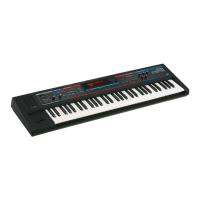94
Effects List
Some effect settings (such as Rate or Delay Time) can be specified in
terms of a note value. The note value for the current setting is shown
following the numerical value.
* If the Rate is specified as a note value, the modulation will be
synchronized with the tempo when you play back SMF song data.
note:
fig.MFX-note2.e_88
If you specify the delay time as a note value, slowing down the
tempo will not change the delay time beyond a certain length.
This is because there is an upper limit for the delay time; if the
delay time is specified as a note value and you slow down the
tempo until this upper limit is reached, the delay time cannot
change any further. This upper limit is the maximum value that
can be specified when setting the delay time as a numerical
value.
The depth of chorus and reverb applied to the sound processed by the
multi-effect is determined by the “Effect Edit” settings “Cho Send Level”
and “Rev Send Level.”
For details, refer to “Editing the Effects (MFX/Chorus/Reverb) (Effect
Edit)” (p. 61).
This is a three-band stereo equalizer (low, mid, high).
This is a stereo spectrum. Spectrum is a type of filter which modifies the
timbre by boosting or cutting the level at specific frequencies.
This is an equalizer which cuts the volume greatly, allowing you to add a
special effect to the sound by cutting the volume in varying ranges.
Boosts the volume of the lower range, creating powerful lows.
About Note
Chorus Send and Reverb Send
Double note
Dotted whole note
Dotted half note
Dotted thirty-second note
Whole note
Double-note triplet
Sixteenth-note triplet
Thirty-second note
Sixty-fourth-note triplet
Sixty-fourth note
Thirty-second-note triplet
Dotted eighth noteQuarter-note tripletEighth note
Half-note tripletQuarter note
Dotted quarter note
Whole-note triplet
Half note
Sixteenth note
Eighth-note triplet
Dotted sixteenth note
01:
EQUALIZER
Item
Value Description
Low Gain
-15–+15 dB
Gain of the low range
Mid Gain
-15–+15 dB
Gain of the middle range
High Gain
-15–+15 dB Gain of the high range
Level
0–127
Output Level
02:
SPECTRUM
Item
Value Description
Band (250Hz)
-15–+15 dB
Gain of each frequency band
Band (1000Hz)
Band (4000Hz)
Level
0–127 Output Level
03:
ISOLATOR
Item
Value Description
Boost/
Cut Low
-60–+4 dB
These boost and cut each of the High,
Middle, and Low frequency ranges.
At -60 dB, the sound becomes
inaudible. 0 dB is equivalent to the
input level of the sound.
Boost/
Cut Mid
Boost/
Cut High
Level
0–127
Output Level
04:
LOW BOOST
Item
Value Description
Boost Gain
0–+12 dB
Amount by which the lower range will be
boosted
Level
0–127 Output level
JUNO-Di_e.book 94 ページ 2009年6月22日 月曜日 午前9時23分

